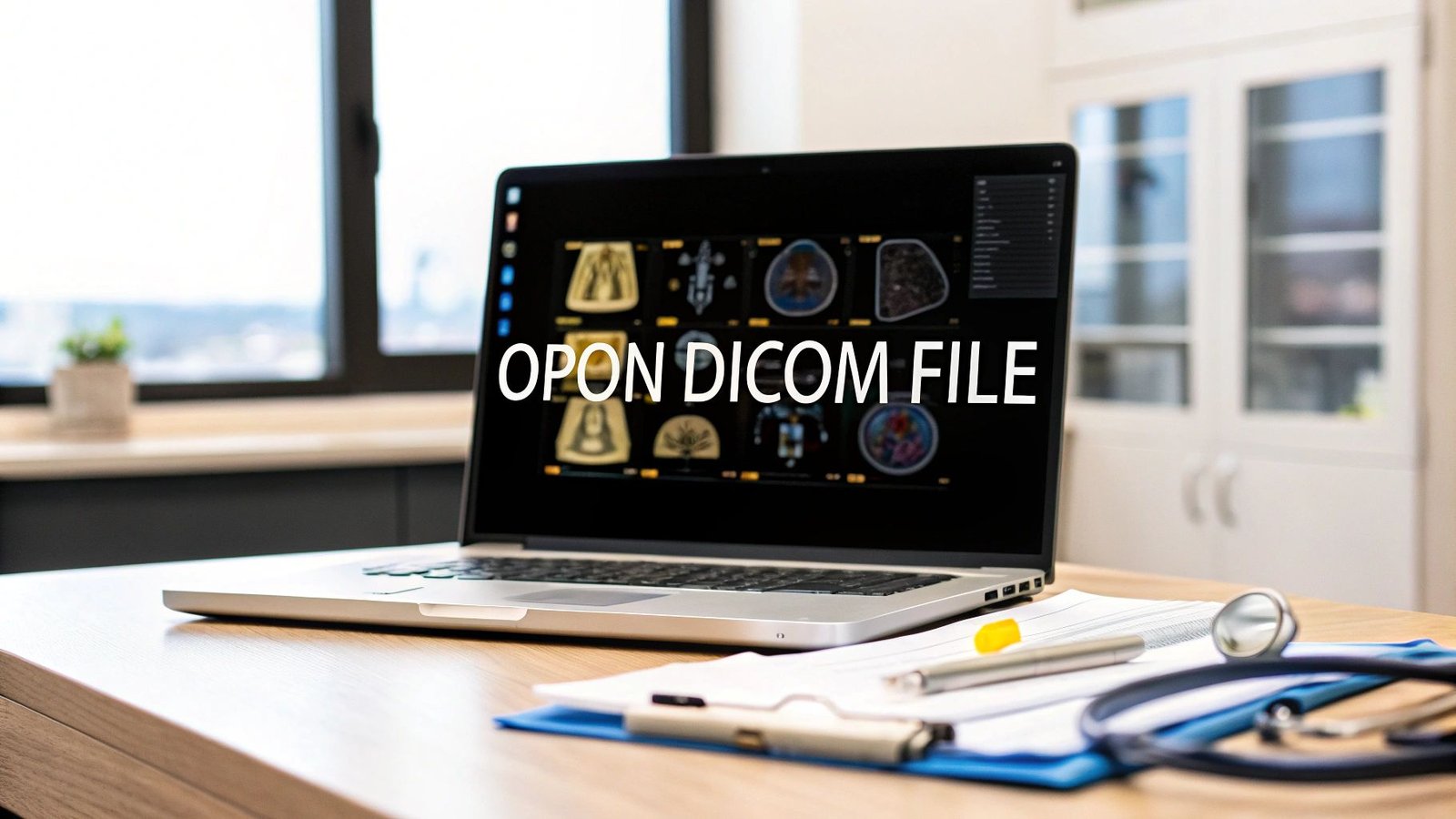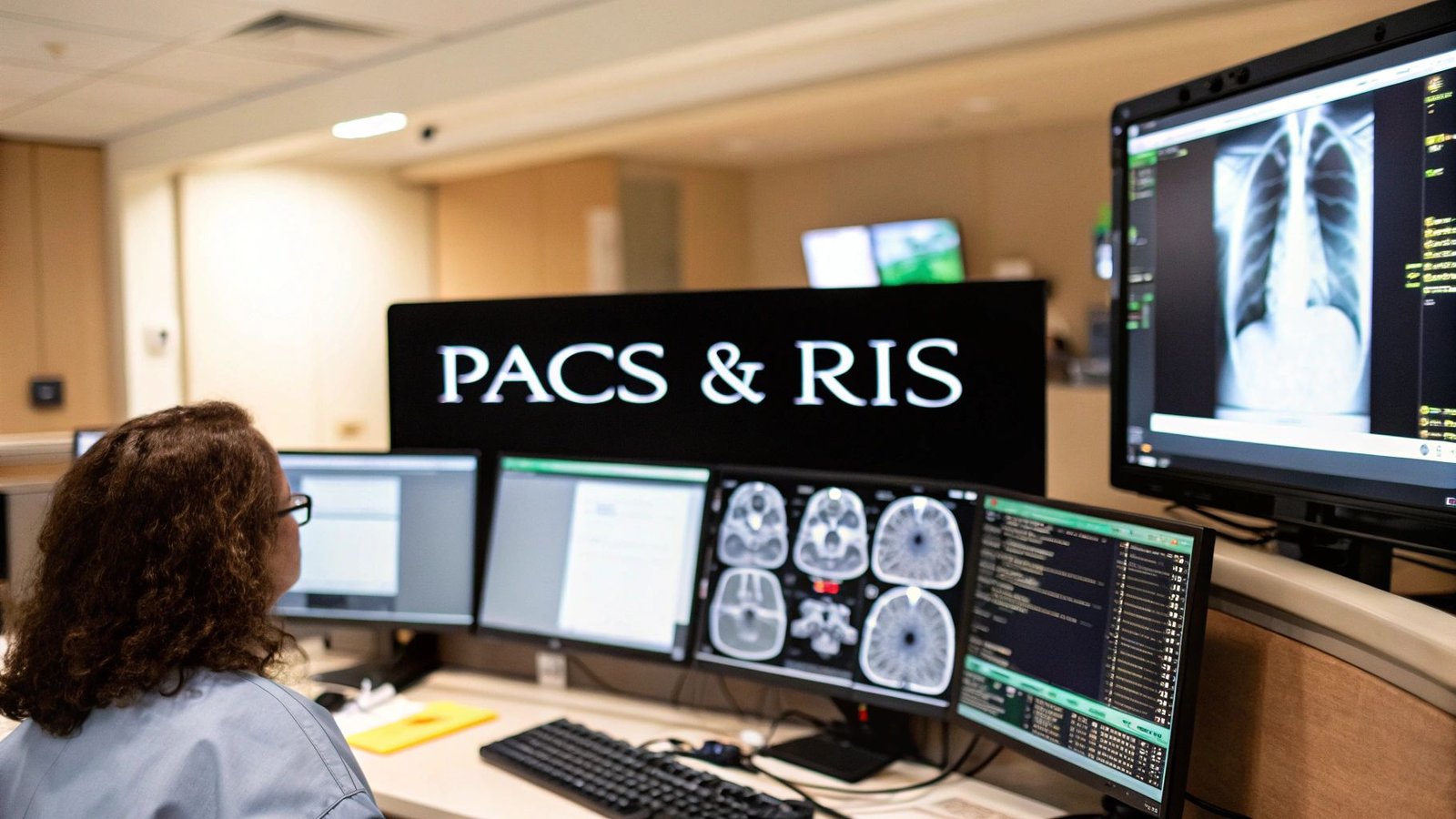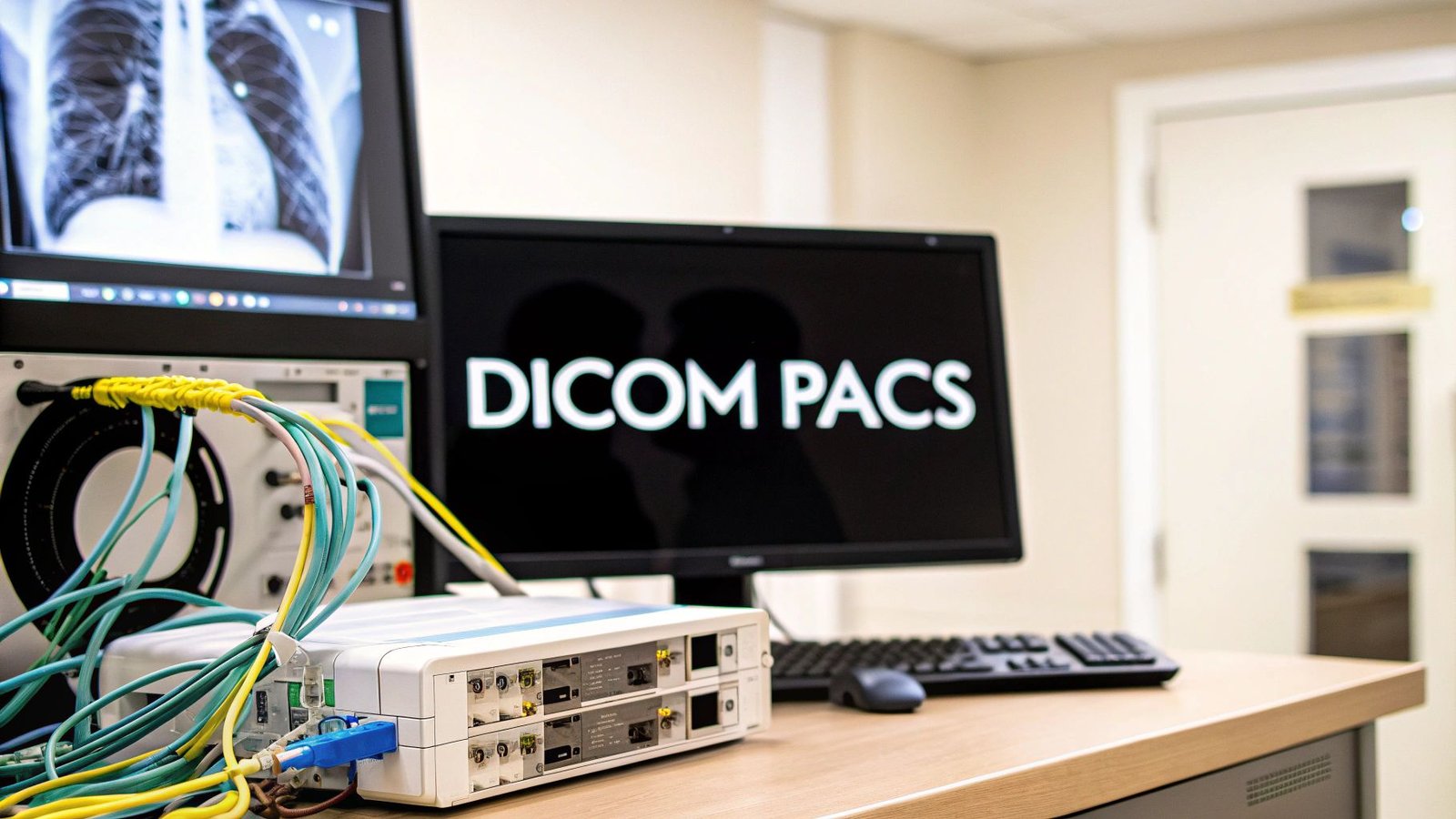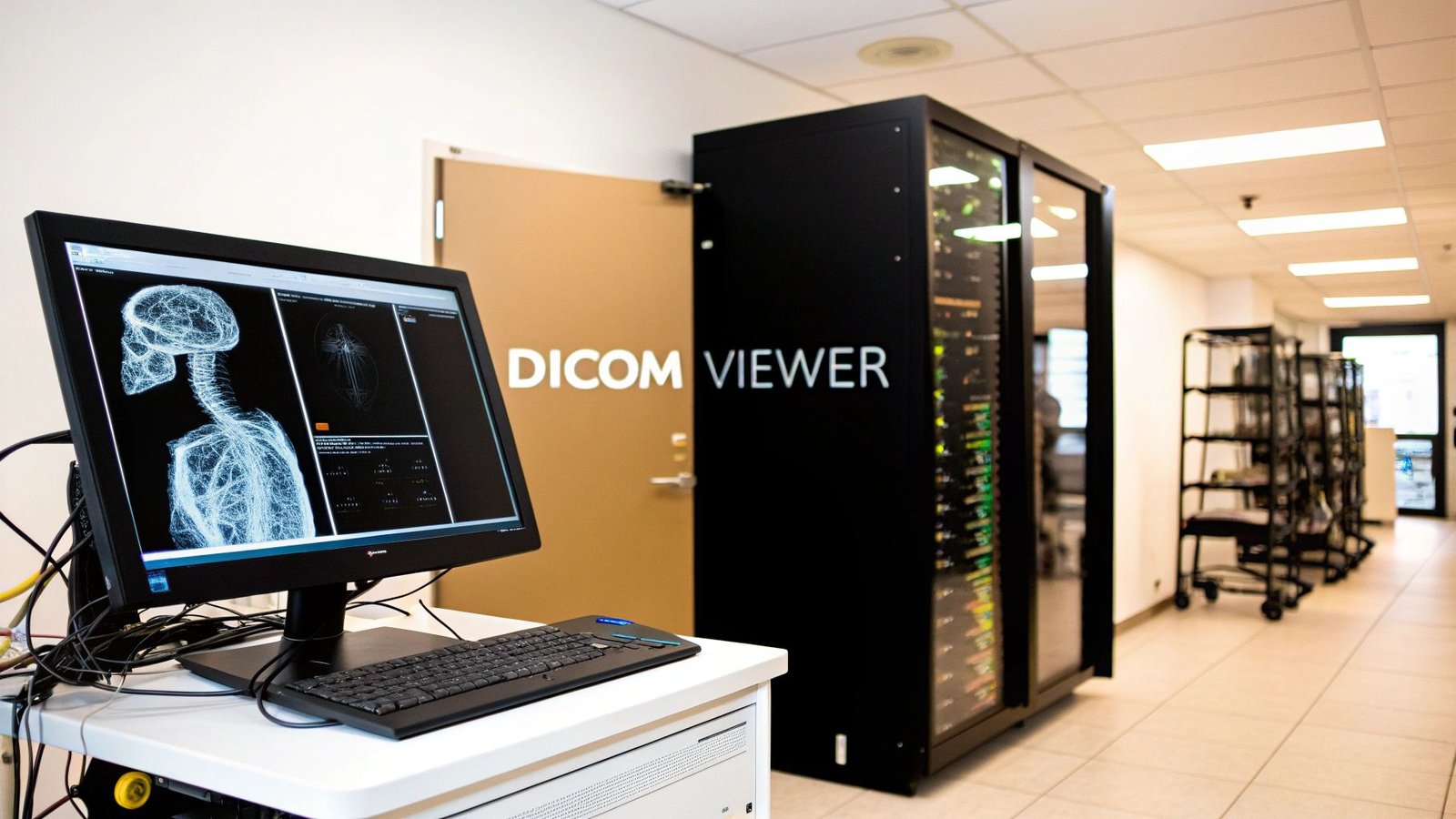Artificial intelligence in healthcare isn't some far-off sci-fi concept anymore. It's a real tool that’s making a tangible difference in patient outcomes and hospital efficiency right now. Think of it less as a replacement for human doctors and more as a collaborative partner that supercharges their expertise. It's fundamentally reshaping everything from medical diagnosis to the mountain of administrative work that often bogs down care.
The New Reality of AI in Healthcare
When people hear "AI in healthcare," their minds often jump to surgical robots from the movies. The reality is actually much more practical and, in many ways, more powerful.
Imagine AI as a tireless medical researcher, one that can sift through colossal amounts of data—from clinical trial results to individual patient histories and genetic markers—to find subtle patterns a human might miss. This gives clinicians the ability to make quicker, more informed decisions, which ultimately elevates the quality of care they can provide.
At the heart of this is machine learning, and it works a lot like a doctor gaining experience over a long career. A seasoned radiologist gets better at spotting tiny anomalies after viewing thousands of scans. In the same way, an AI model learns to recognize patterns by analyzing millions of data points. The difference is, it never gets tired, and its "experience" can encompass the entirety of published medical knowledge.
A Collaborative Medical Partner
The point of AI isn't to take over a doctor's job, but to augment their skills. It's an assistant that handles the heavy lifting of data analysis, freeing up doctors, nurses, and other staff to focus on what humans do best: applying their clinical judgment, communicating with patients, and providing compassionate care. To get a better feel for this new dynamic, it’s worth exploring the 8 ways AI medical staff are reshaping healthcare by automating tasks and offering critical support.
The ultimate goal is to create a partnership between human and machine intelligence. AI provides the scale and speed for data processing, while clinicians provide the context, ethics, and human touch essential for true healing.
Market Growth and Widespread Adoption
This collaborative approach is quickly moving from novel to normal. A clear majority of hospitals are already putting these technologies to work, improving both patient care and their own internal workflows.
The market is certainly reflecting this shift. The AI healthcare market was recently valued at $32.34 billion, and it's not slowing down. Projections show it accelerating to an estimated $431.05 billion by 2032. Discover more insights about AI in healthcare statistics on docus.ai.
The Core Technologies Driving Medical AI
To really understand what AI is doing in healthcare, you have to look under the hood at the engines driving all this change. "AI" isn't some single, magical thing; it's more like a toolkit with several distinct, powerful technologies inside. Once you understand the main components, the incredible results we're seeing in clinics start to make a lot more sense.
The big three are Machine Learning (ML), Natural Language Processing (NLP), and Computer Vision. Each has its own job, but they often work together to solve complex medical problems.
Machine Learning: The Digital Pathologist
At its core, Machine Learning (ML) is all about teaching computers to learn from data without someone having to write code for every single possibility. I like to think of it as training a digital pathologist. A human pathologist becomes an expert by looking at thousands and thousands of tissue samples, slowly learning to spot the incredibly subtle signs of disease.
ML models do something similar. We feed them enormous amounts of medical data—lab results, patient vitals, genetic markers, you name it. By sifting through all this information, the model learns to connect the dots and spot patterns that predict specific outcomes. This is how it can flag which patients are at high risk for sepsis or suggest the most effective treatment for a specific person. It’s a system that builds expertise through digital experience, not years in a lab.
Machine learning gives healthcare the power to shift from a reactive stance of "what happened?" to a proactive one: "what is likely to happen next?"
This predictive power is the absolute bedrock of personalized medicine, where treatments are tailored to a patient's unique biology.
Natural Language Processing: The Universal Translator
So much of what happens in healthcare is communicated through words. Think about doctors' spoken notes, published research papers, or just a patient explaining their symptoms. This information is incredibly valuable, but it's messy and unstructured, making it tough to analyze at scale. That’s where Natural Language Processing (NLP) steps in.
NLP is like a universal translator that allows computers to understand, interpret, and even generate human language. For instance, sophisticated tools like medical voice recognition software can listen to a doctor's dictation and turn it directly into a structured entry in an electronic health record (EHR). This doesn't just save a ton of time; it also cuts down on the errors that sneak in with manual data entry.
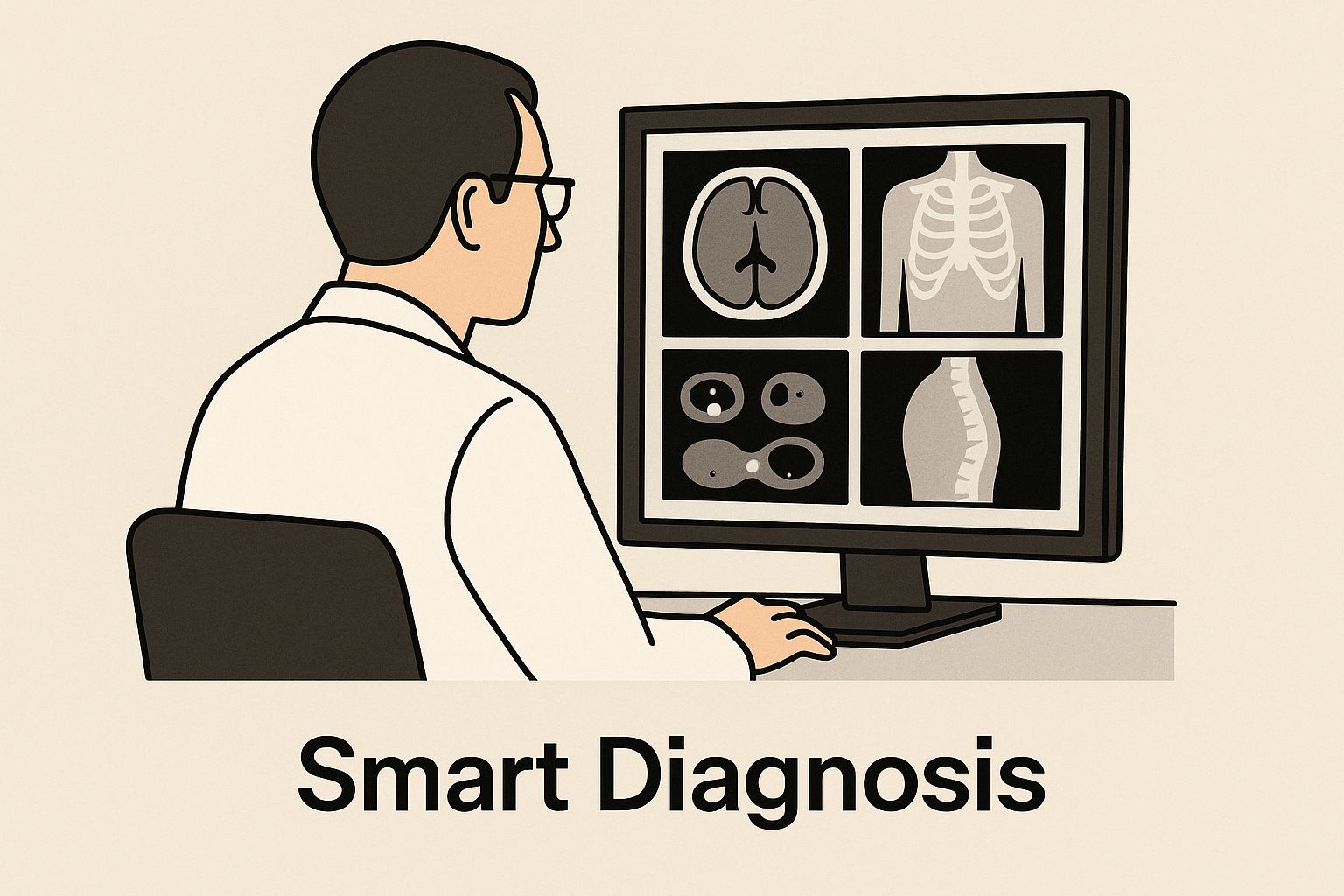
By automating how clinical notes and images are handled, AI frees up specialists like radiologists to pour their expertise into the most challenging and nuanced cases.
Computer Vision: The Superhuman Eye
Finally, there’s Computer Vision. This technology gives machines the ability to "see" and make sense of visual information—which, in healthcare, almost always means medical images. It's like equipping a computer with superhuman sight, allowing it to spot patterns in X-rays, MRIs, and CT scans that might be too faint or complex for the human eye to catch on its own.
This has been a complete game-changer for diagnostics. For example, a Computer Vision algorithm can be trained on tens of thousands of mammograms to flag suspicious areas that might indicate early-stage breast cancer. The precision often matches, and can sometimes even surpass, that of a human expert. It’s not about replacing the radiologist; it’s about providing an incredibly vigilant second pair of eyes to make sure nothing gets missed.
To put it all together, this table shows how each technology plays a distinct role in a clinical setting.
Comparison of Core AI Technologies in Healthcare
| AI Technology | Primary Healthcare Function | Real-World Application Example |
|---|---|---|
| Machine Learning (ML) | Finds patterns in large datasets to predict outcomes and guide personalized treatment. | An algorithm analyzes patient data to forecast their likelihood of hospital readmission, triggering proactive care. |
| Natural Language Processing (NLP) | Understands and structures human language from clinical notes, reports, and patient speech. | An ambient scribe tool listens to a doctor-patient conversation and automatically creates a clinical summary for the EHR. |
| Computer Vision | Analyzes medical images to identify anomalies and support accurate diagnosis. | An AI scans a chest X-ray to detect early signs of lung cancer or pneumonia, highlighting key areas for the radiologist's review. |
As you can see, each technology tackles a different type of medical data, but they all share the same goal: to extract meaningful insights that help clinicians make better, faster decisions.
How AI Is Sharpening Clinical Decisions
The real magic happens when AI moves from the data center to the examination room. This is where artificial intelligence stops being a buzzword and starts acting as a powerful new partner for clinicians. It’s not about replacing doctors; it’s about giving them a co-pilot with incredible analytical power to sharpen their diagnostic skills and help them make faster, more confident decisions.
One of the clearest wins for AI is in medical imaging. Think of it like this: an AI algorithm can be a tireless specialist that analyzes a CT scan or MRI with a level of speed and precision that's hard to match. It meticulously scans every single pixel, flagging potential trouble spots—like tiny tumors just beginning to form or subtle signs of neurological disease—that the human eye might miss during a packed workday.
This capability does more than just improve accuracy; it dramatically cuts down the agonizing wait times for patients. Instead of days, results can be triaged in minutes. This lets radiologists focus their attention where it's needed most, accelerating the entire diagnostic timeline so treatment can start sooner.
Bridging Gaps in Healthcare Access
Beyond the hospital, AI is also becoming a critical tool for getting quality care to more people. Let's face it, seeing a doctor isn't always simple, especially for those in remote areas or juggling unconventional work schedules. AI-powered platforms are tackling this head-on by bringing initial guidance directly to the patient, wherever they are.
These tools can walk a person through a series of questions about their symptoms, similar to what a triage nurse would do. Based on the answers, the system can suggest the right next step, whether that's heading to the ER, scheduling a telehealth call, or trying an over-the-counter remedy. It makes getting care more straightforward and efficient for everyone.
By acting as a force multiplier for medical expertise, AI helps clinicians diagnose conditions earlier, create more personalized treatment plans, and improve patient outcomes on a massive scale.
And this isn't some far-off future. At the University of Cambridge, an AI tool can diagnose coeliac disease in seconds. In New York City, platforms use AI to deliver physician-guided diagnostics for gig economy workers. And institutions like Penn Medicine are sifting through hospital data with AI to better pinpoint risks for long COVID patients. You can find out more about how AI is reshaping clinical decisions at the HIMSS Conference.
Real-World Diagnostic Partnerships
The teamwork between clinicians and AI is already producing real results across different medical fields. The goal is always the same: combine the machine's analytical brute force with the doctor's nuanced understanding of the individual patient.
Here are a few examples of how this partnership looks in the real world:
- Dermatology: A patient snaps a picture of a suspicious mole with their phone. A computer vision algorithm instantly analyzes the image, cross-referencing it with a massive database of skin lesions to flag the risk of malignancy before a dermatologist even lays eyes on it.
- Cardiology: AI models keep a constant watch on ECG data from wearable devices, catching irregular heart rhythms like atrial fibrillation in real time. The system can alert both the patient and their doctor, potentially heading off a crisis long before it happens.
- Ophthalmology: AI is a game-changer for screening for diabetic retinopathy, a leading cause of blindness. An algorithm can analyze retinal images and instantly spot signs of the disease, flagging the case for timely intervention that can save a person's sight.
In every case, the AI delivers a rapid, data-backed assessment that a human expert then verifies and acts on. This two-step process delivers both accuracy and compassionate, context-aware care—and that's the true promise of artificial intelligence for healthcare.
Predicting Health Crises Before They Happen
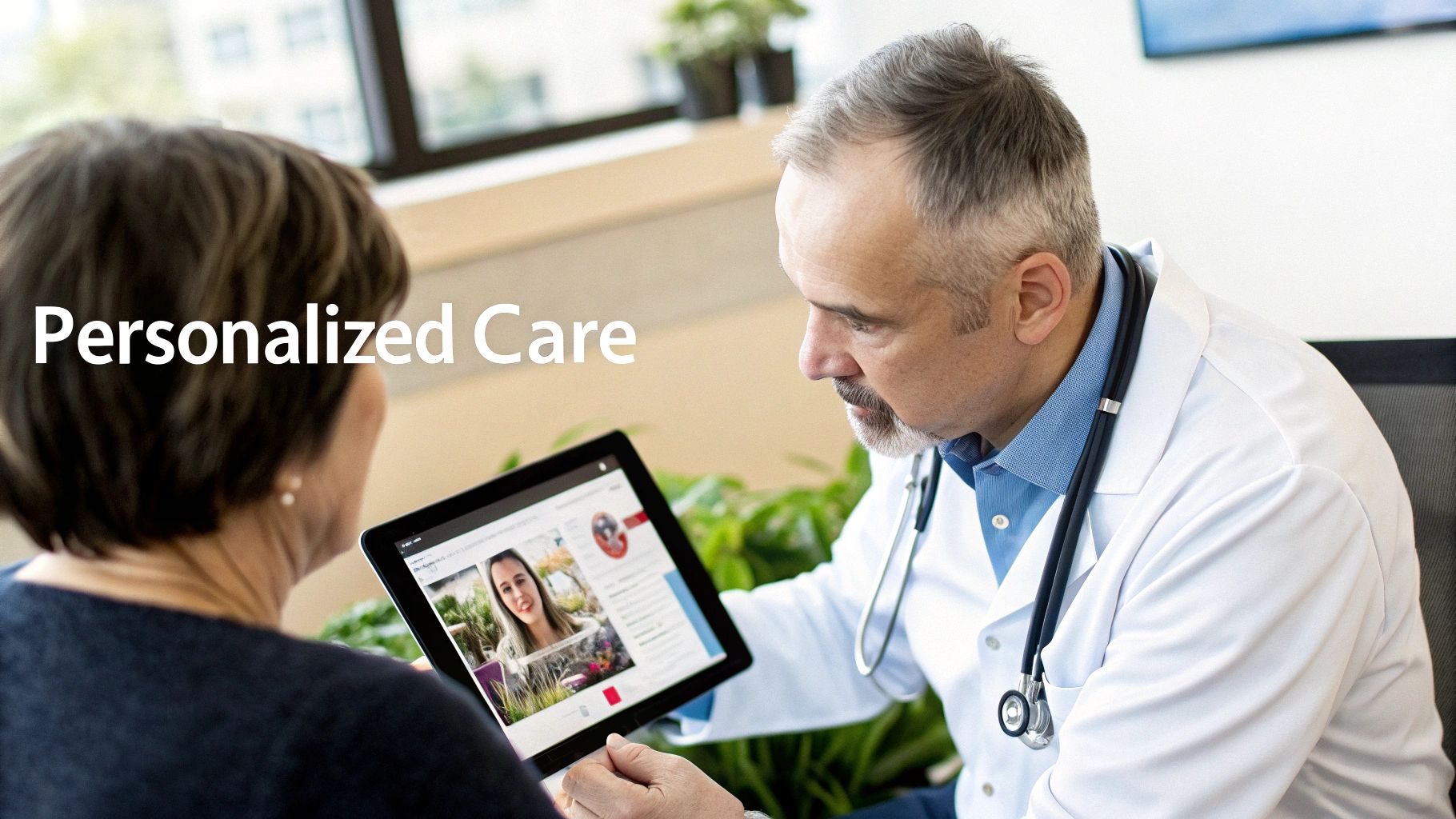
What if you could stop a major health crisis before the first clear symptom ever appeared? This isn’t a far-off hypothetical anymore. It's the new frontier of proactive medicine, and it's being driven by predictive analytics. This specific use of artificial intelligence for healthcare is completely flipping the script on medical intervention, moving us away from simply reacting to illness and toward preventing it altogether.
Think of these AI models as a highly advanced health "weather forecast." But instead of crunching data on atmospheric pressure and wind patterns, they comb through the vast ocean of information in a patient's electronic health record (EHR). They spot subtle, interconnected signals hidden in lab results, vital signs, medication histories, and even doctors' notes—patterns a person could easily miss.
These signals are the early warnings of a storm brewing on the horizon, like the onset of sepsis, heart failure, or an acute kidney injury. The AI isn't just making a guess; it's calculating risk based on what it's learned from millions of past patient cases. This gives it the incredible ability to flag a high-risk individual long before their condition escalates into a full-blown emergency.
Shifting From Reaction to Prevention
This predictive power represents a massive shift in how we deliver care. For decades, medicine has mostly been reactive. A patient feels sick, they see a doctor, and then treatment begins. Predictive analytics turns that entire model on its head.
Instead of waiting for a patient to decline, the clinical team gets an alert that someone’s risk profile is heading in a dangerous direction. This gives them a crucial window to step in with targeted actions.
For instance, an AI might flag a post-operative patient as having a high probability of developing sepsis. Armed with that insight, a nurse can monitor them more frequently, or a doctor can order specific lab tests to investigate further—all before classic signs like fever or a drop in blood pressure even show up. That early action can be the difference between a minor issue and a life-threatening event.
The real value of predictive AI is its knack for making the invisible visible. It finds the risks building silently inside a patient's body, giving clinicians the priceless gift of time to act decisively and prevent a bad outcome.
The Tangible Impact on Hospitals
This isn't just theory—predictive AI is already deployed in hospitals and making a dramatic, measurable difference. It’s becoming a standard tool embedded right into the EHR systems clinicians use every single day.
The adoption numbers alone tell the story. Roughly 65% of U.S. hospitals are now using AI-powered predictive models. The trend is global, with some reports showing that up to 92% of healthcare leaders have already adopted or are in the process of implementing predictive analytics. These tools are proven to cut hospital readmission rates by as much as 50% and reduce unnecessary medical tests by 30%. You can explore detailed statistics on AI's role in healthcare on tempdev.com to see just how widespread this has become.
By flagging high-risk patients for early intervention, hospitals are seeing real, practical benefits:
- Fewer Emergency Readmissions: When you can predict potential complications before a patient even goes home, you can adjust their discharge plan and follow-up care. This drastically reduces the odds of them ending up back in the ER.
- Reduced Strain on Resources: Preventing a crisis is always more efficient than managing one. Early interventions typically require fewer resources than full-scale emergency care, which eases the load on ICUs and specialized staff.
- Improved Patient Outcomes: This is the most important one. Patients get better care. Heading off conditions like sepsis or cardiac events doesn't just save lives; it often leads to shorter hospital stays and better long-term health.
At the end of the day, predictive analytics is helping build a smarter, more resilient healthcare system. It's a perfect example of how artificial intelligence for healthcare isn't just about futuristic gadgets but about delivering practical, life-saving improvements to patient care right now.
Running a Smarter Hospital with AI
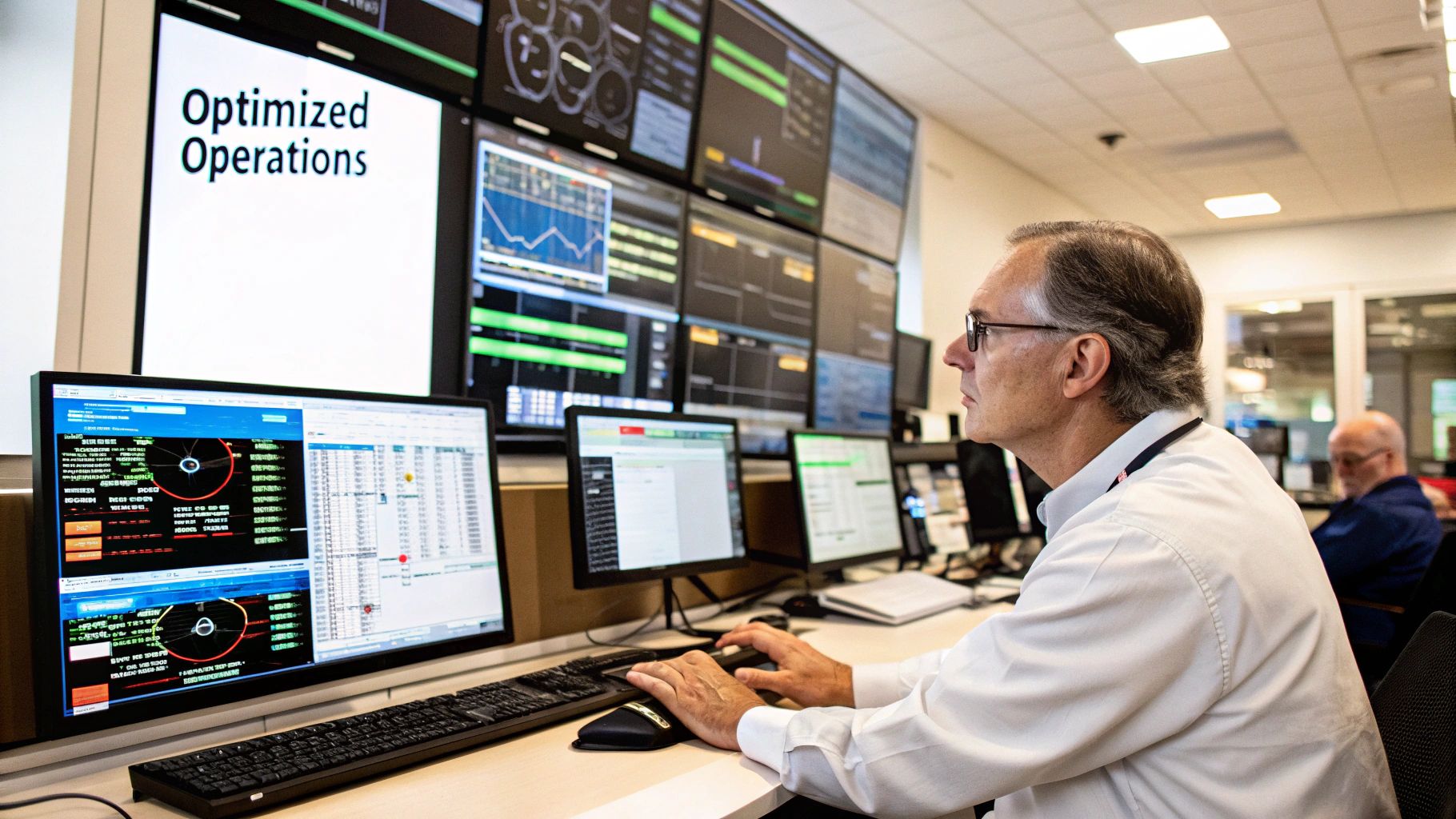
While AI is making huge waves in diagnostics and treatment, its impact on the very bones of the hospital is just as profound. A hospital is a dizzyingly complex system with thousands of moving parts. Think of artificial intelligence for healthcare as the new operating system, bringing a sense of order and efficiency to the controlled chaos of daily operations.
This isn't just about direct patient care; it's about the business of running a modern medical center. AI tools are helping optimize entire facilities, creating a clear financial reason to bring them on board. They help reduce waste, cut costs, and ultimately create a smoother experience for both patients and the clinicians caring for them.
Optimizing Staff and Patient Flow
One of the biggest operational puzzles for any hospital administrator is managing the constant ebb and flow of patients and staff. Overstaffing a quiet floor wastes money, but understaffing a busy one risks patient safety and burns out your best people. AI offers a much smarter way to handle this balancing act.
By digging into historical admission data, local health trends, and even factors like seasonal flu patterns, predictive algorithms can forecast patient surges with surprising accuracy. It’s like a demand forecast for hospital beds. This gives administrators the power to build intelligent staff schedules, ensuring the right number of doctors and nurses are always where they’re needed most.
A great example of this is how AI scribe systems are changing the game for doctors. By automatically generating clinical notes after each patient visit, some of these tools can slash documentation time by up to 75%, giving physicians more time to actually focus on their patients.
This kind of foresight also helps with patient discharge, another classic bottleneck. AI can pinpoint which patients are medically ready to go home and even flag potential delays, helping care teams coordinate to free up beds more quickly.
Creating an Intelligent Supply Chain
In a hospital, running out of a critical drug or a specific piece of equipment simply isn't an option. Yet, traditional inventory management is often manual, clunky, and prone to human error. AI is stepping in to build an intelligent, self-managing supply chain.
Instead of relying on staff to do manual counts, AI systems can track inventory in real time. They learn usage patterns and can automatically reorder supplies before they get dangerously low, preventing stockouts of essentials like surgical gloves, catheters, or specific medications. This means clinicians can trust that what they need will always be there.
This kind of automation doesn't just improve safety; it also slashes waste from expired products and over-ordering, leading to some serious cost savings across the entire institution.
Taming the Administrative Beast
Let's be honest: the administrative side of healthcare is a notorious source of frustration and inefficiency. Medical billing and coding, for example, are incredibly complex processes that eat up countless hours. A single coding error can get a claim denied, delaying payments and creating a cascade of extra work.
AI is taking on this administrative nightmare. Tools using Natural Language Processing (NLP) can scan a doctor's notes and instantly suggest the correct medical codes for billing. This not only speeds up the reimbursement cycle but also helps fight insurance fraud more effectively.
By automating these repetitive, rule-based tasks, artificial intelligence for healthcare frees highly trained staff from mountains of paperwork. They can then focus on what really matters—direct patient interaction, managing complex cases, and improving the quality of care. The result is a more efficient, financially stable hospital where people, not paperwork, are the priority.
Navigating the Ethical Maze of Medical AI
AI offers incredible promise for healthcare, but with that power comes a serious responsibility. We can't just unleash these tools without thinking through the real-world ethical consequences. These aren't just details to iron out later; they're fundamental questions we have to answer to make sure AI helps patients safely and fairly.
It all starts with patient data. AI models are data-hungry, needing massive datasets to learn and make accurate predictions. This immediately opens up a can of worms about how we collect, store, and use sensitive health information. We have to be incredibly strict, following privacy regulations like HIPAA to the letter to protect patient confidentiality.
The Problem of Algorithmic Bias
One of the biggest risks is accidentally building our own biases into the very algorithms designed to help. If an AI is trained on data that mostly reflects one demographic, its insights could be flat-out wrong for others. This is a recipe for worsening health disparities, with the technology failing the very communities that need it most.
This happens when training data isn't diverse enough. For instance, an algorithm trained mostly on data from male patients might miss heart attack symptoms in women, which often show up differently. Fixing this takes a conscious, deliberate effort to audit datasets for fairness right from the start.
The core challenge is that an AI system doesn't understand fairness or empathy; it only understands the data it's given. If that data contains historical biases, the AI will learn and even amplify them, making equitable care a top ethical priority.
Demanding Transparency with the Black Box
Another huge hurdle is the "black box" problem. This is when an AI gives a recommendation—say, flagging a patient as high-risk—but doctors have no idea how it reached that conclusion. This lack of transparency kills trust and makes it nearly impossible for clinicians to confidently use AI insights in their daily work.
For artificial intelligence for healthcare to truly take hold, we need what's called explainable AI (XAI). Doctors need to see the "why" behind an AI's output so they can verify its reasoning and ultimately take responsibility for the final care decision. As these tools become more common, clear ethical guidelines and AI usage policies are absolutely essential for protecting patients and their data.
The point isn't to create fear, but to build a responsible path forward. By tackling data privacy, algorithmic bias, and transparency head-on, we can keep patient safety and ethical principles right at the center of medical AI innovation.
Answering Your Questions About AI in Healthcare
As artificial intelligence finds its way into more and more parts of the medical field, it’s only natural for both patients and providers to have questions. This technology is incredibly powerful, and really understanding its role is the key to building trust and making the most of what it offers. Let's tackle some of the most common questions to clear up how artificial intelligence for healthcare actually works in the real world.
The most frequent question is also the biggest one: will AI take over doctors' jobs? The answer is a clear and resounding no.
Will AI Replace Doctors and Healthcare Professionals?
The expert consensus is firm: AI is here to augment, not replace, healthcare professionals. It’s best to think of AI as a remarkably capable partner—a tool that can analyze data, spot patterns, and handle administrative work on a scale that humans just can't. It’s the ultimate assistant, not a replacement for the person in charge.
This actually frees up doctors, nurses, and other clinicians to focus on what they do best. They can now spend more time on direct patient interaction, making complex ethical judgments, and providing the empathetic, human-centered care that is so crucial for healing. AI can boost a doctor's diagnostic accuracy and efficiency, but it completely lacks the critical thinking and human touch that will always be the heart of medicine.
What Is the Biggest Barrier to Adopting AI?
One of the most significant hurdles is simply getting new AI systems to talk to the existing hospital infrastructure, especially the Electronic Health Record (EHR) systems. Many facilities are built on older, legacy platforms that weren't designed to connect with modern AI tools, which turns data sharing into a major technical headache.
Beyond the technical side, several other important barriers stand in the way:
- Ensuring Data Security: Protecting sensitive patient data from any potential breach while using that same data to train AI models is a delicate, high-stakes balancing act.
- Navigating Regulations: The healthcare industry is bound by complex rules like HIPAA. Making sure every new AI tool is compliant requires meticulous planning and execution.
- Addressing Algorithmic Bias: We have a responsibility to make sure AI tools deliver fair and equitable results for all patient populations, without amplifying existing health disparities.
- Securing Investment: Getting the budget and buy-in from stakeholders for such a major technological shift is often a major challenge in itself.
How Can a Small Clinic or Hospital Start Using AI?
Smaller organizations don't need to dive into a massive, hospital-wide overhaul to get started. The smartest approach is to begin with a specific, high-impact problem and find a focused solution for it.
A great starting point is to adopt AI-powered tools that are already built into the software you use every day. Many modern EHR systems now come with embedded AI features that can automate administrative tasks or offer clinical decision support right out of the box.
Another accessible entry point is using AI-powered medical transcription services, which can dramatically cut down on documentation time for clinicians. By focusing on solving a tangible pain point—like improving billing accuracy or reducing patient no-shows—a small clinic can see immediate value from artificial intelligence for healthcare without a scary upfront investment. This strategy allows for a gradual, scalable adoption that proves its worth at every step.
At PYCAD, we specialize in making this transition smooth and effective. We help medical device companies and healthcare innovators integrate sophisticated AI into their imaging solutions, from data annotation all the way to model deployment. Learn how PYCAD can advance your medical imaging capabilities.


